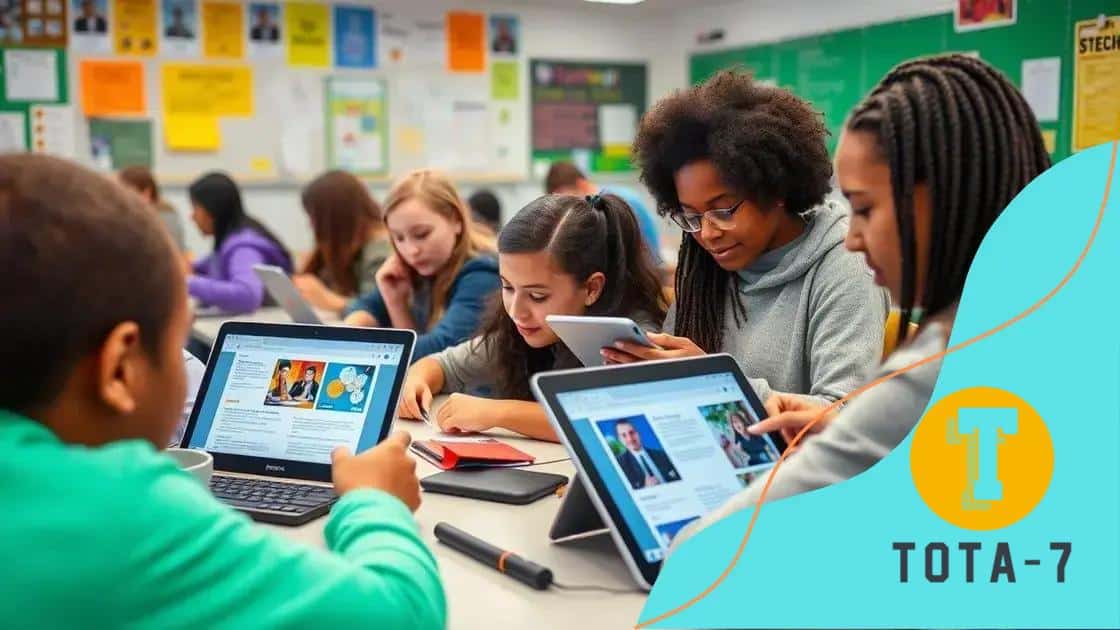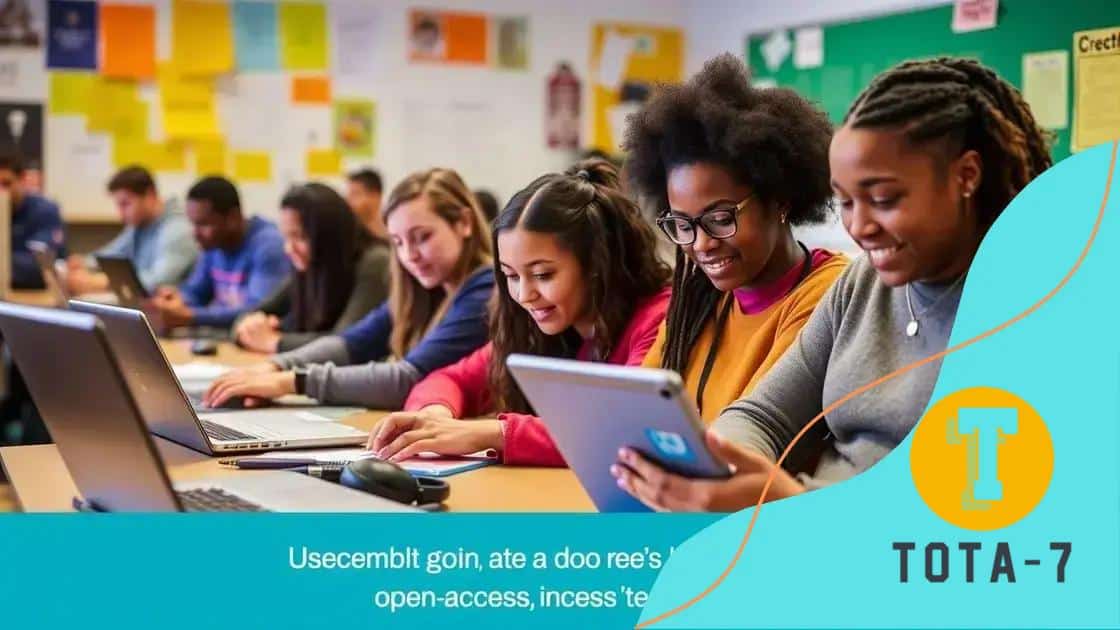Open-access textbooks disrupt higher education publishing

Open-access textbooks disrupt higher education publishing by providing free and accessible educational resources, thus enhancing equity and learning outcomes while presenting challenges for traditional publishers.
Open-access textbooks disrupt higher education publishing, creating new pathways for students and institutions alike. Imagine being able to access crucial academic resources without the hefty price tag. Curious about how this shift is shaping the educational landscape?
Understanding open-access textbooks
Understanding open-access textbooks is essential as they play a significant role in today’s educational landscape. These resources make learning materials freely available, breaking down financial barriers that often hinder students.
With open-access textbooks, there are various advantages that enhance learning experiences. Here are some key points to consider:
Key Benefits
- Affordability: Students can access high-quality textbooks without the burden of high costs.
- Accessibility: Resources are available to anyone with an internet connection, ensuring wider reach and inclusion.
- Collaboration: Authors and educators can contribute to and improve textbooks over time, making them more relevant.
This collaborative effort not only enriches the educational content but also allows for immediate updates when necessary. Furthermore, open-access textbooks often encourage creative approaches to learning. In many cases, these textbooks can be modified and adapted to suit different teaching methods and learning styles.
Moreover, since these resources are freely accessible, they promote equity in education. Institutions can ensure that all students, regardless of their financial situation, have access to the same quality materials. This democratization of knowledge is vital for fostering an inclusive learning environment.
In addition to affordability and accessibility, using open-access textbooks may lead to improved educational outcomes. Students who have the necessary materials readily available tend to perform better academically. As a result, the overall quality of education can see significant improvement.
Challenges to Consider
While the benefits are clear, there are also challenges that accompany the adoption of open-access textbooks. Some educators worry about the quality of materials available online compared to traditional resources. However, many open-access textbooks undergo rigorous peer review processes to ensure they meet academic standards.
Ultimately, understanding open-access textbooks allows students and educators to make informed choices about their educational resources. Adopting these materials can lead to a brighter, more equitable future for all learners.
Benefits of open-access in education

The benefits of open-access in education are numerous and impactful. They transform the way students and educators access knowledge and learning materials. By removing the financial barriers associated with traditional textbooks, open-access resources create a more equitable educational environment.
One significant advantage is that students can access crucial learning materials without worrying about costs. This accessibility helps improve overall educational equity, allowing every student the same opportunity to learn.
Improved Learning Outcomes
Studies indicate that students using open-access materials often demonstrate better academic performance. When students have free and easy access to resources, they can study at their own pace, leading to a deeper understanding of the subject matter. Furthermore, instant access to learning materials means students can start their work without delay.
- Tutoring opportunities are enhanced as tutors can easily share resources with their students.
- Group studies can become more productive as all members have access to the same materials.
- Flexible learning supports varied learning styles, helping students thrive.
Additionally, open-access resources encourage innovation in teaching and learning. Educators can freely share and adapt materials, making it easier to create engaging lesson plans tailored to their specific students. This adaptability ensures that teaching remains relevant and effective.
Another major benefit is that open-access textbooks are often updated more frequently than traditional textbooks. As researchers discover new information or changes in their field, they can quickly revise and publish new editions. This means students have access to the latest research and developments in real-time.
Challenges faced by publishers
While the rise of open-access textbooks brings many advantages, it also presents significant challenges for publishers. Understanding these obstacles is essential for navigating the evolving landscape of educational materials.
One major challenge is the business model adjustment. Traditional publishing relies heavily on sales revenue from textbooks. With open-access materials available for free, publishers must find new ways to generate income. This might include offering supplemental resources or charging for print versions of these textbooks.
Maintaining Quality Standards
Another critical issue is ensuring the quality of content. While peer reviews are integral to maintaining standards, the rapid publication process of open-access materials can sometimes sidestep thorough review protocols. Publishers must focus on how to uphold quality while still being responsive to the needs of educators and students.
- Implementing rigorous peer review processes.
- Creating clear guidelines for authors and contributors.
- Establish systems to revise and update materials as necessary.
Publishers also face challenges in awareness and outreach. Many educators and students may not be fully aware of available open-access options. Thus, publishers must invest in marketing strategies that highlight the benefits of accessing these resources. Promoting these materials requires collaboration with educational institutions.
Furthermore, the competition from free online resources creates pressure. Numerous websites provide free content that may not meet academic standards. Publishers must differentiate their offerings and demonstrate the added value of using structured, peer-reviewed materials.
Lastly, navigating intellectual property challenges is crucial. Creators and institutions alike must understand how to share and use open-access materials correctly. Publishers need to clarify licensing terms and ensure authors retain appropriate rights over their work.
Impact on student learning and accessibility

The impact of open-access resources on student learning and accessibility is profound. These materials provide students with the chance to access high-quality educational content without the heavy financial burden of traditional textbooks.
Accessibility is a core benefit of open-access textbooks. Students can obtain resources online anytime and anywhere, ensuring they have the tools needed for their educational journey. This flexibility promotes self-directed learning, allowing students to study at their own pace and revisit challenging topics as needed.
Enhancing Educational Equity
The use of open-access materials significantly levels the playing field among students from different socio-economic backgrounds. With free access to educational content, there is less disparity in the quality of educational resources available to students. This improved access fosters collaboration among peers who can share information and study together freely.
- Students can reach their full potential with the right materials.
- Group assignments become more efficient as everyone has access to the same resources.
- Teachers can create more inclusive lesson plans tailored to diverse learning styles.
Furthermore, the positive impact on student learning is supported by research showing that students who engage with openly accessible materials often achieve better grades. Consistent access to updated information allows students to rely on accurate academic resources.
Additionally, the user-friendly nature of many open-access platforms enhances the learning experience. Features like search functions and interactive elements make it easier for students to locate information efficiently, encouraging deeper engagement with the study material. Open access removes barriers that traditionally hinder student participation and learning.
Overall, the integration of open-access resources promotes a culture of learning that is collaborative and equitable. It empowers students to take charge of their education and cultivates an environment where everyone can succeed.
Future trends in open-access publishing
Future trends in open-access publishing are shaping the way educational content is created, shared, and consumed. As technology continues to advance, the landscape of educational resources is set to transform even further.
One major trend is the increasing integration of digital platforms for distribution. Publishers are leveraging online technologies to reach wider audiences. This transition enables faster updates and the ability to adapt materials based on user feedback.
Emerging Technologies
Another important trend involves the use of artificial intelligence and data analytics. Publishers can analyze how students interact with materials, allowing them to understand which resources are most effective. This data helps in creating customized learning experiences that cater to diverse student needs.
- AI can assist in content creation by suggesting topics based on current trends.
- Data analytics provides insights into usage patterns, helping refine educational resources.
- Personalized learning paths can be developed to optimize student engagement.
Moreover, collaboration among educational institutions and publishers is becoming more common. These partnerships can lead to the sharing of resources and expertise, enhancing the overall quality of open-access materials. Institutions may collaborate on research and development, resulting in innovative teaching methods and course structures.
Another noteworthy trend is the rise of community-driven resource creation. Educators are increasingly contributing to open-access projects, sharing their insights and materials. This grassroots effort fosters a culture of collaboration and democratization of knowledge. Furthermore, these community initiatives often produce high-quality content that reflects real classroom needs.
As open-access publishing gains traction, new funding models are also emerging. Traditional models based on textbook sales may evolve into membership or subscription-based systems, allowing for sustained revenue while keeping content free for users. These innovative funding solutions can ensure the sustainability of open-access resources.
In conclusion, the future of open-access textbooks brings exciting changes to the education landscape. With improved accessibility, students from all backgrounds can access valuable learning materials without financial barriers.
Publishers face challenges, but innovative solutions like AI, collaboration, and community-driven efforts are paving the way for a more inclusive educational environment.
As more institutions embrace these resources, we can expect a shift toward greater equity in education, supporting diverse learning styles and needs. The trends we see today signal a positive transformation that aims to empower both students and educators alike.
FAQ – Frequently Asked Questions about Open-Access Textbooks
What are open-access textbooks?
Open-access textbooks are educational materials that are freely available online, allowing anyone to access and use them without paying.
How do open-access textbooks impact student learning?
They enhance student learning by providing free access to high-quality resources, which can improve academic performance and engagement.
What challenges do publishers face with open-access materials?
Publishers must adjust their business models, ensure the quality of content, and adapt to new funding solutions to sustain their operations.
What future trends can we expect in open-access publishing?
We can expect increased collaboration between educational institutions, the use of AI for personalized learning, and innovative funding models for sustainability.





